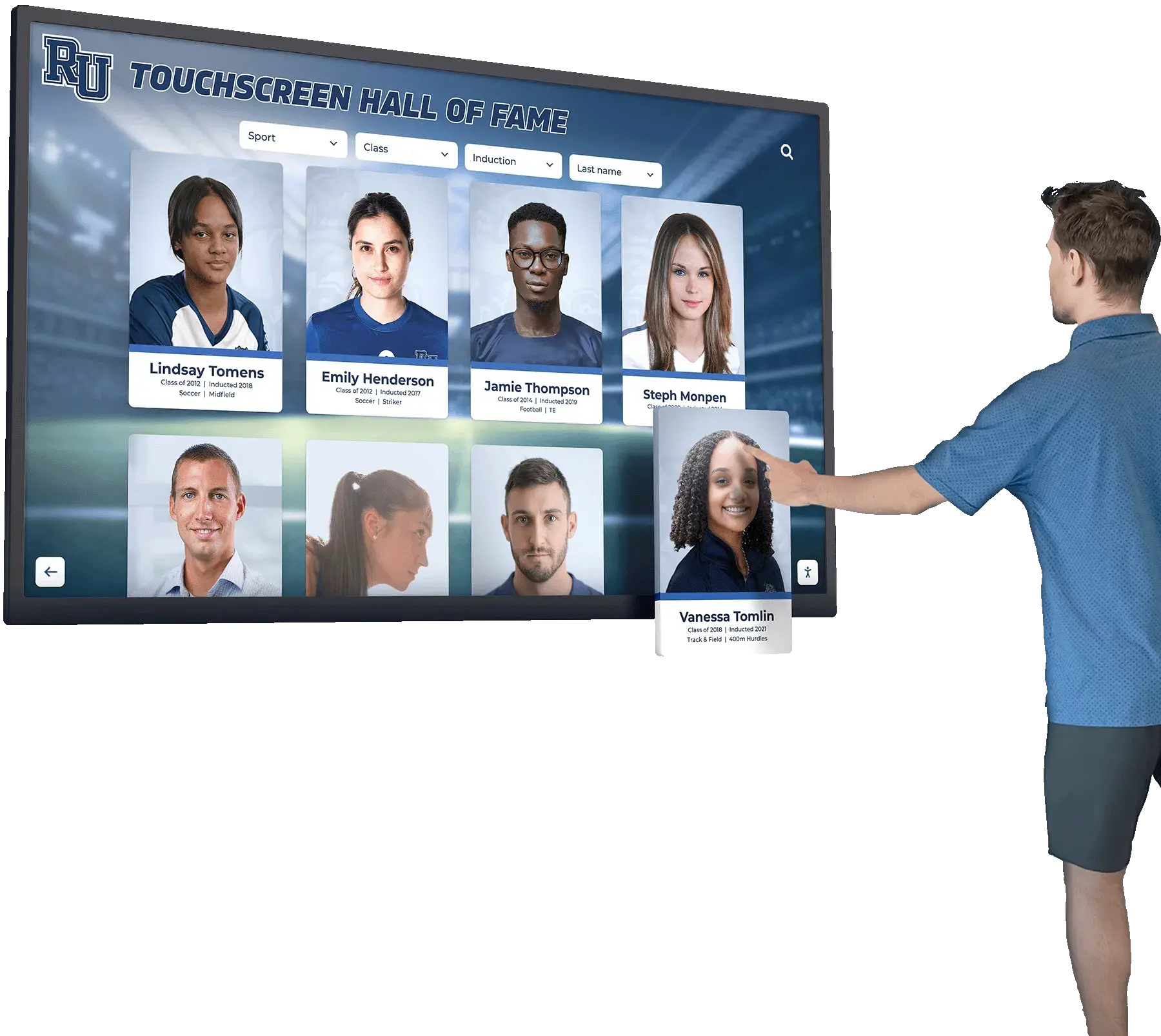Alumni recognition programs serve as powerful tools for celebrating distinguished graduates while strengthening institutional identity, inspiring current students, and fostering lifelong connections between individuals and their alma maters. From formal awards ceremonies honoring exceptional achievement to comprehensive digital displays showcasing decades of graduate excellence, effective recognition transcends simple acknowledgment—it creates lasting value for institutions, alumni, and entire communities connected to educational missions.
Yet many schools and organizations struggle to implement alumni recognition that feels meaningful, sustainable, and aligned with contemporary expectations. Traditional plaques fill available wall space, creating capacity constraints. Annual awards ceremonies attract limited attendance. Recognition feels disconnected from broader institutional advancement goals. Alumni remain unaware of programs honoring their peers, missing opportunities for connection and inspiration.
This comprehensive guide explores how to build alumni recognition programs that genuinely celebrate achievement while delivering measurable institutional value through enhanced engagement, strengthened culture, improved advancement outcomes, and inspired student populations. Whether launching your first formal recognition initiative or modernizing existing programs constrained by outdated approaches, these strategies and best practices provide actionable frameworks for creating recognition that honors alumni appropriately while serving multiple institutional priorities simultaneously.
The Strategic Value of Alumni Recognition Programs
Alumni recognition delivers returns extending far beyond ceremonial acknowledgment. Well-designed programs strengthen emotional bonds between graduates and institutions, inspire current students through visible examples of achievable success, create pride among families and communities, establish foundations for sustained philanthropic support, demonstrate institutional quality through graduate achievement, and preserve institutional legacy documenting excellence across generations. Solutions like Rocket Alumni Solutions enable institutions to implement comprehensive recognition systems that honor every deserving graduate while creating engaging experiences that strengthen connections and advance institutional missions.
Understanding Alumni Recognition Program Types and Purposes
Different recognition approaches serve distinct institutional objectives, and understanding these variations helps schools design programs aligned with specific goals while maximizing impact across multiple dimensions.
Distinguished Alumni Awards and Halls of Fame
Highly selective recognition programs honor graduates who have achieved exceptional distinction in professional careers, community service, or contributions bringing particular honor to their alma maters. These prestigious programs typically induct small cohorts annually through rigorous selection processes evaluating nominations against published criteria.
Distinguished alumni programs create aspirational standards demonstrating what extraordinary achievement looks like while providing institutions with compelling stories for advancement communications, recruitment materials, and community relations. Selectivity maintains recognition prestige—not every successful graduate receives induction, only those demonstrating truly exceptional accomplishment meeting defined excellence thresholds.
Selection criteria commonly consider professional achievement and career distinction, community service and philanthropic contribution, institutional support through time or resources, character demonstration embodying institutional values, impact on profession or community, and role model potential for current students. Written criteria enable transparent, defensible decisions while ensuring consistency across selection cycles and committee compositions.

Annual induction ceremonies create special events celebrating new honorees through formal programs, biographical presentations, acceptance speeches, reception opportunities for community engagement, and media coverage extending recognition reach. These ceremonies provide compelling reasons for alumni to return to campus while generating content for ongoing communications and social media engagement throughout the year.
Programs implementing comprehensive alumni hall of fame displays benefit from establishing clear processes for nomination, evaluation, and selection that maintain program credibility while ensuring thorough consideration of all worthy candidates.
Career Achievement and Professional Recognition
Field-specific awards celebrate alumni excellence within particular professional domains, creating multiple pathways to recognition beyond single hall of fame designations. Career recognition categories commonly include business leadership and entrepreneurship, scientific and medical achievement, education and academic excellence, public service and government contribution, arts and creative professional success, athletic and coaching distinction, legal and judicial accomplishment, and technology and innovation leadership.
Specialized categories enable broader recognition acknowledging diverse definition of success and achievement across varied career paths. Young graduates pursuing arts careers see recognition opportunities equal to business leaders, educators receive acknowledgment parallel to medical professionals, and community organizers gain visibility alongside corporate executives.
This inclusive approach demonstrates that institutions value multiple forms of contribution and achievement rather than privileging certain career paths through exclusive recognition. Breadth matters—comprehensive programs celebrate the full spectrum of ways alumni create value and make meaningful impacts in their communities and professions.
Service and Contribution Recognition
Institutional loyalty awards honor alumni who have demonstrated exceptional support through volunteer service, mentorship, fundraising leadership, board governance, or sustained engagement strengthening institutional mission and community. These recognition programs acknowledge that supporting one’s alma mater constitutes its own form of distinguished contribution worthy of formal celebration.
Service recognition categories typically include outstanding volunteer awards for consistent engagement contributions, mentorship recognition honoring student and young alumni support, fundraising leadership acknowledging philanthropic impact, board service appreciation for governance contribution, ambassador awards for recruitment and representation excellence, and reunion leadership celebrating class engagement coordination.
Recognizing service alongside professional achievement communicates institutional values emphasizing community contribution and collective advancement over individual accomplishment alone. Service awards also strengthen volunteer pipelines by demonstrating that institutions notice, value, and celebrate engagement contributions through formal recognition programs.
Alumni providing donor recognition support represent particular constituencies worthy of thoughtful acknowledgment balancing appreciation with appropriate boundaries maintaining recognition program integrity.
Designing Effective Alumni Recognition Selection Processes
Credible recognition programs require transparent selection processes ensuring fair, defensible decisions that maintain standards while accommodating evolving institutional contexts and priorities.
Establishing Clear Recognition Criteria
Written eligibility standards prevent confusion and maintain program credibility by clearly defining who qualifies for consideration and what achievements merit recognition:
Eligibility Requirements: Most programs establish minimum time since graduation (typically 5-10 years for distinguished achievement, 3-5 years for young alumni awards) ensuring sufficient career development and perspective on accomplishments. Degree completion requirements confirm institutional connection authenticity, while character standards reserve recognition for individuals whose conduct aligns with institutional values during and after student years.
Achievement Thresholds: Quantifiable accomplishments provide objective baselines for recognition consideration. Professional recognition might require documented career distinction through leadership positions, industry awards, publications, patents, or comparable markers of field-level excellence. Service thresholds might specify minimum volunteer hours, fundraising impact, or sustained engagement demonstrating commitment beyond casual involvement.
Relative vs. Absolute Standards: Some programs evaluate achievement relative to opportunity and circumstance—alumni overcoming significant obstacles or achieving distinction despite limited resources may merit recognition even when absolute accomplishment levels differ from graduates with greater advantages. This contextual evaluation enables more equitable recognition acknowledging that pathways to achievement vary substantially.
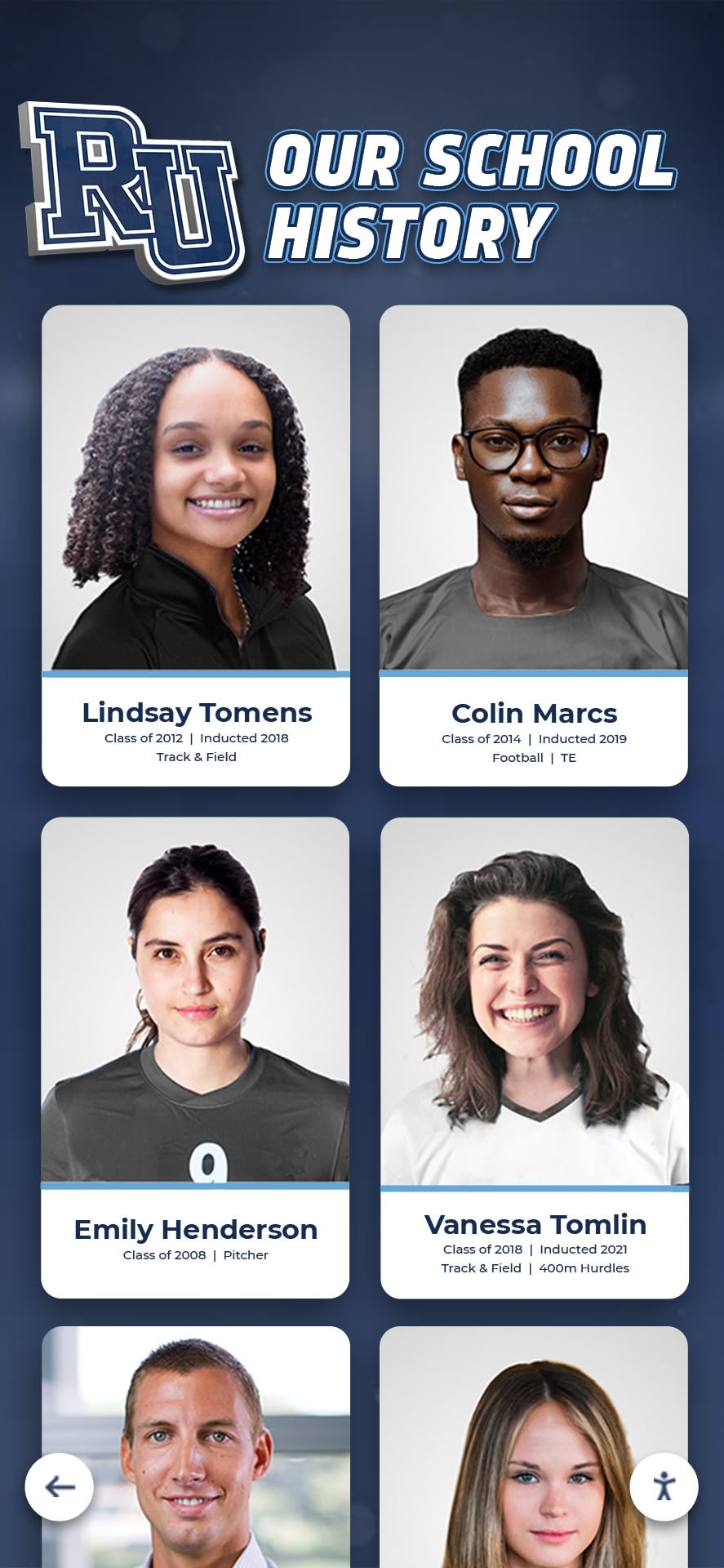
Programs establishing high school alumni recognition benefit from criteria acknowledging both absolute achievement and growth relative to starting points, creating recognition systems that honor excellence achieved through varied pathways.
Nomination and Evaluation Processes
Structured nomination procedures ensure systematic consideration while enabling diverse stakeholder participation:
Open Nomination Periods: Annual nomination windows (typically 2-4 months) allow adequate time for thorough proposal preparation while creating predictable recognition opportunities. Publicize deadlines through alumni communications, institutional websites, social media, and direct outreach to key constituencies including reunion classes, affinity groups, and geographic alumni chapters.
Standardized Nomination Forms: Require specific information ensuring consistent evaluation quality—biographical details, complete achievement summaries with supporting documentation, reference contacts who can verify accomplishments, and nominee statements or third-party essays articulating recognition case. Standardization enables committee members to compare candidates fairly rather than evaluating submissions of varying detail and quality.
Selection Committee Composition: Diverse committees bring varied perspectives preventing single-viewpoint dominance while ensuring comprehensive evaluation. Typical membership includes institutional leadership providing strategic perspective, faculty representatives understanding academic excellence, alumni association leaders maintaining community connection, advancement professionals linking recognition to institutional goals, and sometimes student representatives offering current learner viewpoints.
Evaluation and Voting Procedures: Document committee processes establishing clear evaluation frameworks, scoring rubrics aligning with published criteria, vote thresholds required for selection (commonly 75% committee approval), conflict-of-interest recusal protocols, and decision rationale documentation. Transparency builds confidence in process integrity while creating accountability ensuring decisions reflect genuine merit rather than favoritism or bias.
Appeals and Reconsideration Policies
Fair processes acknowledge that initial decisions may occasionally overlook worthy candidates or occur before achievement fully matures:
Programs typically allow nominations to remain active for defined periods (2-3 years) enabling reconsideration without requiring repeated submissions. Unsuccessful nominees become eligible for new nominations after waiting periods allowing additional achievement accumulation. Some programs proactively reconsider near-miss candidates from previous cycles as committee composition changes bring fresh perspectives.
Clear communication with nominators explaining decision rationales (while maintaining appropriate confidentiality) demonstrates respect for nomination efforts while providing guidance for potential future submissions when additional achievement develops.
Alumni Recognition Display and Communication Strategies
Recognition impact depends not just on selection rigor but on visibility, accessibility, and communication quality ensuring honorees receive meaningful acknowledgment while broader communities learn about and engage with alumni achievement.
Traditional Physical Recognition Displays
Conventional display formats maintain appeal for many institutions valuing tangible, permanent recognition:
Engraved Plaque Walls: Individual brass or bronze plaques mounted on dedicated wall space create impressive displays conveying permanence and prestige. Each plaque typically includes name, graduation year, induction year, and brief achievement summary. Professional engraving ensures lasting quality, and traditional materials develop patina many find aesthetically appealing.
Primary limitations include per-person costs ($150-$400 typically), eventual space exhaustion requiring difficult expansion decisions, and update/correction challenges requiring complete replacement. Nevertheless, plaque walls satisfy stakeholders valuing tangible recognition while creating formal gravitas appropriate for distinguished achievement acknowledgment.
Trophy Cases and Shadow Boxes: Glass-enclosed displays showcase physical achievement artifacts—awards, medals, publications, memorabilia, or donated items representing alumni accomplishments. Three-dimensional displays create engaging visual interest while preserving tangible connections to recognized individuals and their achievements.
Consider rotating displays periodically showcasing different honorees or achievement types, preventing cases from feeling static while allowing greater total content than simultaneous display capacity accommodates.
Naming Opportunities: Significant achievements merit permanent recognition through buildings, rooms, scholarships, programs, or facilities bearing alumni names. These high-profile acknowledgments create lasting institutional presence while providing natural fundraising themes appealing to donors seeking meaningful naming opportunities.

Traditional approaches work well for institutions with available space, sustainable budgets for ongoing expansion, and stakeholder preferences favoring tangible recognition. However, capacity constraints eventually force difficult decisions about which achievements merit limited physical space.
Modern Digital Recognition Systems
Digital platforms overcome traditional format limitations while adding powerful capabilities impossible with physical displays:
Unlimited Recognition Capacity: Digital systems accommodate unlimited honorees without space constraints. Whether recognizing 50 distinguished graduates or 5,000 across all achievement levels, display footprint remains constant. As programs grow, adding inductees requires content updates rather than physical construction, eliminating capacity decisions that exclude worthy individuals due to space limitations.
Rich Multimedia Storytelling: Video interviews capturing alumni reflections in their own voices, photo galleries documenting career progressions, achievement timelines visualizing accomplishments, scanned articles and press coverage, audio recordings, and extensive biographical narratives create comprehensive profiles impossible with physical plaques limited to name and brief text.
This depth transforms recognition from name listings into compelling experiences helping audiences understand achievement context, career journeys, institutional connections, and personal dimensions that make alumni relatable rather than abstract listings.
Searchable, Filterable Databases: Visitors instantly locate specific individuals by name, explore honorees from particular decades, filter by achievement type or career field, browse by geographic location, or discover alumni through keyword searches. These capabilities create personalized exploration experiences rather than forcing sequential browsing through alphabetical or chronological listings.
Remote Accessibility and Sharing: Web-integrated systems extend recognition globally, enabling alumni worldwide to explore program honors regardless of physical campus proximity. Social sharing capabilities amplify recognition reach as honorees share profiles across personal networks, creating visibility extending far beyond institutional audiences.
Real-Time Updates and Analytics: When new inductees join programs, displays update immediately rather than waiting months for plaque fabrication. Analytics reveal engagement patterns—which profiles attract greatest interest, peak usage times, search behaviors—informing continuous improvement ensuring recognition remains impactful.
Solutions like Rocket Alumni Solutions provide purpose-built platforms designed specifically for educational recognition rather than generic digital signage requiring extensive customization. Purpose-built systems deliver intuitive content management, professional templates, ongoing support, and continuous platform evolution responding to changing institutional needs.
Resources exploring digital alumni recognition benefits demonstrate how modern platforms transform recognition from space-constrained displays into comprehensive experiences honoring institutional heritage while engaging contemporary audiences.
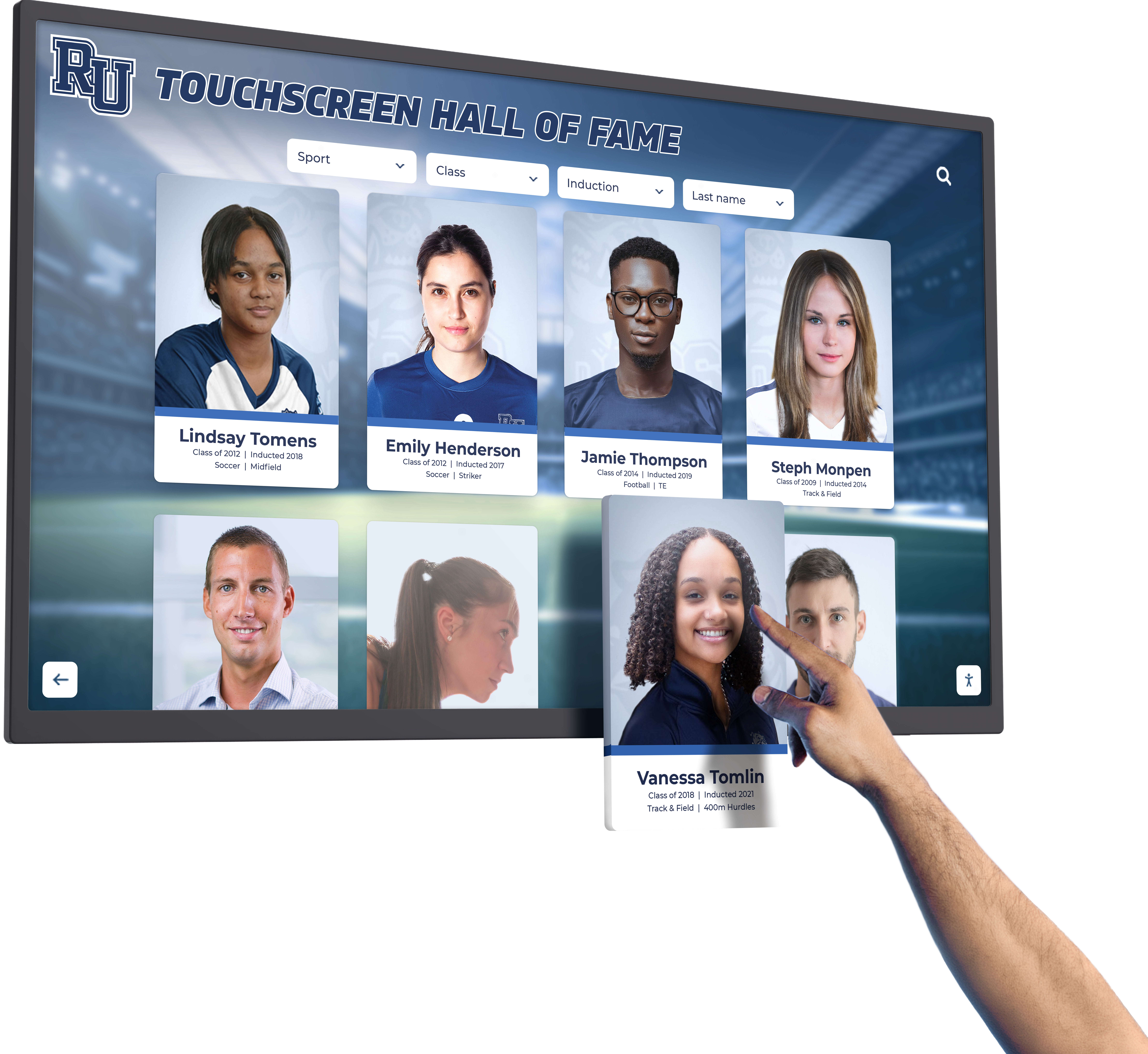
Hybrid Recognition Approaches
Combined physical and digital recognition delivers advantages of both formats, satisfying stakeholders valuing tangible displays while embracing digital capabilities expanding recognition reach and depth:
Many programs successfully maintain traditional elements—prominent plaque walls for most recent inductees, trophy cases displaying select memorabilia, naming opportunities for highest distinction—while implementing digital displays providing expanded content, historical depth, and unlimited capacity. This balanced approach honors tradition while embracing innovation addressing practical constraints and contemporary engagement expectations.
Consider positioning digital displays adjacent to traditional recognition, creating seamless transitions where physical plaques introduce honorees while interactive screens enable visitors to explore detailed profiles, view video interviews, examine photo galleries, and discover related content. This integration leverages complementary strengths rather than forcing either/or choices between formats.
Content Development for Compelling Alumni Recognition
Technology enables recognition but compelling content creates impact. Developing rich, accurate profiles requires systematic approaches ensuring consistent quality across all honorees.
Biographical Research and Information Gathering
Comprehensive profiles require thorough information collection from multiple sources:
Primary Source Development: Direct outreach to honorees yields authentic, detailed information unavailable elsewhere. Questionnaires requesting biographical details, achievement summaries, career milestones, institutional reflections, and advice for current students provide foundation content. Follow-up interviews (phone, video, or in-person) add depth, capturing voice and personality impossible through written questionnaires alone.
When honorees participate in content development, recognition feels more personal while ensuring accuracy and authenticity. Alumni appreciate opportunities to shape their representation while contributing advice and reflections valuable for student audiences.
Secondary Research: Public records, news articles, professional profiles, published works, institutional archives, and peer references supplement primary information, providing context and verification. Secondary research proves particularly valuable for deceased honorees or individuals unable to participate directly, enabling comprehensive recognition despite limited direct engagement.
Student and Faculty Perspectives: For recent graduates, former professors, advisors, coaches, and peers provide valuable perspectives on character, achievement context, and institutional contributions. These third-party observations add authenticity while highlighting aspects honorees might modestly underemphasize in self-reported information.
Multimedia Content Creation
Visual and audio elements transform static text into engaging experiences:
Professional Photography: Quality images dramatically affect display professionalism. Commission professional headshots when possible, or provide guidelines enabling honorees to submit professional-quality photos meeting resolution, composition, and format standards. For historical honorees, digitally restore archival photos improving quality while preserving authenticity.
Video Interview Production: Brief video interviews (3-7 minutes typically) create powerful personal connections. Focus on career journey narratives, memorable institutional experiences, achievement stories highlighting turning points, advice for current students, and reflections on institutional impact. Professional lighting and audio quality matter, but authentic content outweighs production polish—audiences value genuine reflection over highly produced but impersonal videos.
Document and Artifact Digitization: Scan awards, certificates, news clippings, photos, or documents illustrating achievement context. These artifacts add authenticity while creating visual interest supplementing standard biographical content.
Resources on interactive recognition displays demonstrate effective multimedia integration creating engaging experiences that honor achievement while inspiring audiences through relatable storytelling.
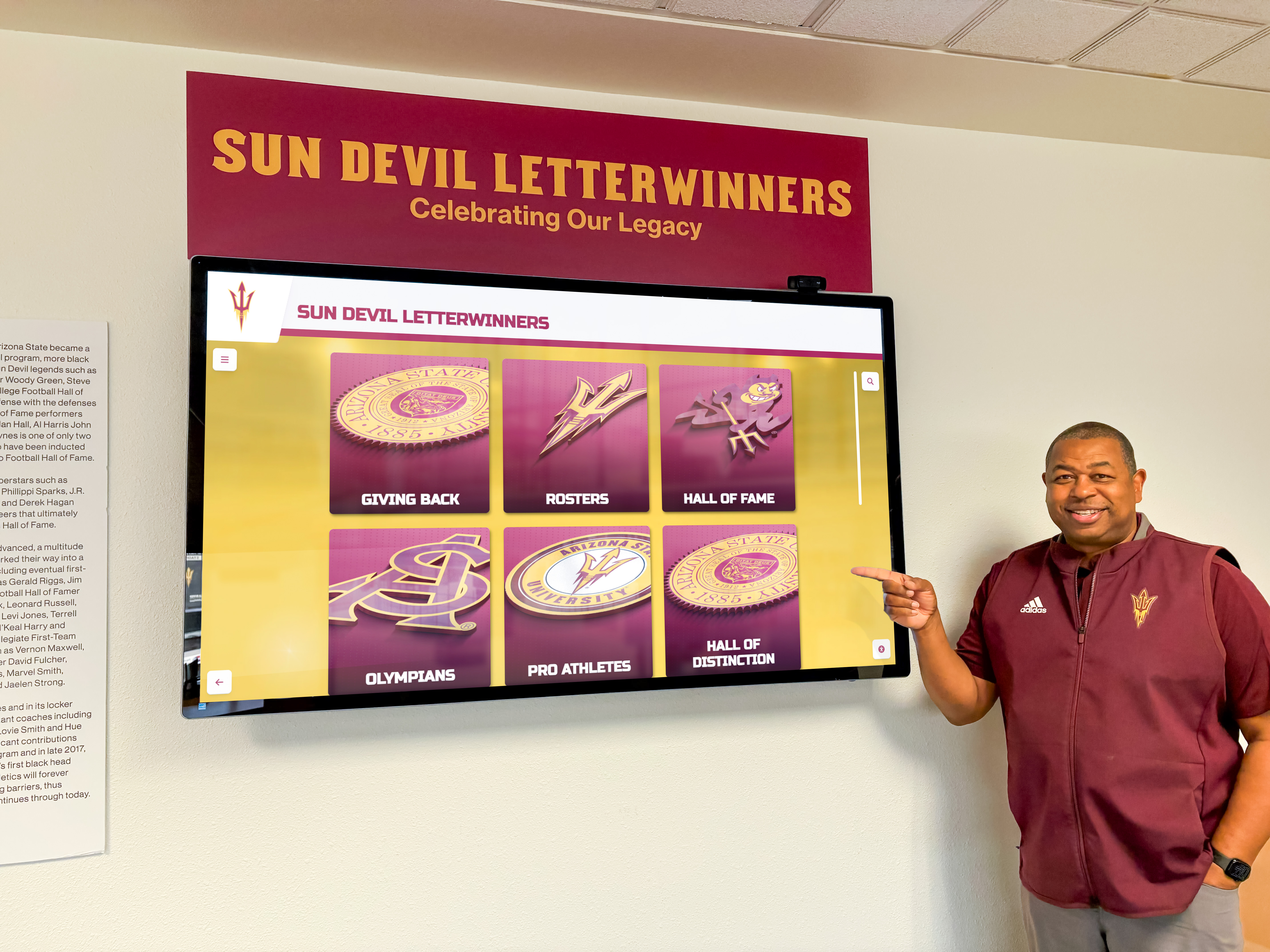
Writing Style and Tone Guidelines
Consistent voice maintains professionalism while creating engaging, accessible content:
Achievement Focus: Emphasize accomplishments and impact rather than simply listing positions and titles. “Led research team developing treatment now used by 500,000 patients annually” conveys more meaning than “Served as Director of Medical Research.” Specific impact metrics help audiences understand achievement significance.
Accessibility: Avoid jargon, unexplained acronyms, or technical terminology limiting accessibility. Recognition reaches broad audiences including families, prospective students, community members, and alumni from different fields—content should remain comprehensible regardless of reader background.
Inspiration and Connection: Include elements helping current students see themselves in alumni stories—challenges overcome, turning points, moments of doubt, unexpected opportunities, or formative experiences connecting back to institutional contexts. These personal dimensions make achievement feel accessible rather than intimidatingly distant.
Factual Accuracy: Verify all claims, statistics, dates, and specific accomplishments. Errors undermine program credibility and demonstrate disrespect for honorees who deserve accurate representation. When information uncertainty exists, use appropriate qualifiers or omit unverified details rather than risk inaccuracy.
Alumni Recognition Program Operations and Sustainability
Successful programs require operational structures ensuring consistent quality, manageable workload, and sustainable processes surviving staff transitions and leadership changes.
Annual Program Calendars and Timelines
Structured schedules create predictability while ensuring adequate time for thorough execution:
Nomination Period (January-March typically): Publicize nomination opportunities widely, provide resources supporting strong submissions, offer assistance to nominators needing guidance, and confirm receipt of all nominations with acknowledgment communications.
Selection Process (April-May): Distribute nomination materials to committee members, facilitate evaluation discussions, conduct voting following established procedures, notify selectees and unsuccessful nominees appropriately, and begin planning induction ceremony and content development.
Content Development (June-August): Coordinate with inductees on profile information, conduct interviews, commission photography, write and edit biographical content, develop multimedia elements, and prepare display and publication materials.
Induction Ceremony and Launch (September-November): Execute recognition event, unveil physical or digital display additions, distribute publicity, activate social media campaigns, and engage inductees in ongoing institutional activities and mentorship opportunities.
This annual rhythm creates manageable workload distribution while building anticipation through predictable recognition cycles that become anticipated institutional traditions.
Sustainable Resource Allocation
Programs require realistic resource commitment including staff time for coordination, content development, and ongoing management; budget allocation for ceremonies, displays, marketing, and honoree outreach; volunteer coordination for alumni-led committee work; technology maintenance for digital platforms; and continuous improvement activities ensuring programs evolve appropriately.
Institutions should size programs matching available resources rather than overextending capabilities through recognition approaches requiring more investment than sustainable long-term. Modest programs executed excellently create more value than ambitious initiatives undermaintained due to resource constraints.
Digital recognition platforms significantly reduce operational burden compared to traditional physical displays requiring ongoing fabrication, installation, and space management. Many institutions report 70-85% reductions in recognition maintenance time after implementing digital systems, freeing staff capacity for higher-value activities including inductee engagement, content enhancement, and strategic program development.
Measuring Program Impact and Effectiveness
Assessment informs continuous improvement while demonstrating program value justifying continued investment:
Quantitative Metrics: Track participation rates in nomination processes, induction ceremony attendance, digital display engagement analytics, social media reach and interaction, giving rates among recognized alumni, and volunteer service levels among honorees. Quantitative data reveals usage patterns and engagement trends enabling evidence-based decisions.
Qualitative Feedback: Gather inductee satisfaction through surveys and conversations, collect current student perspectives on recognition inspiration value, assess community sentiment through formal and informal feedback, and evaluate program reputation through external observations and peer comparisons.
Institutional Outcome Connections: Document relationships between recognition programs and advancement metrics—correlation between robust recognition and overall giving rates, volunteer engagement levels, reunion attendance, and survey-measured alumni connection strength. While causation proves difficult to establish definitively, positive correlations support recognition value arguments.
Programs implementing alumni engagement strategies can measure recognition contribution to broader engagement outcomes demonstrating value extending beyond ceremonial acknowledgment.
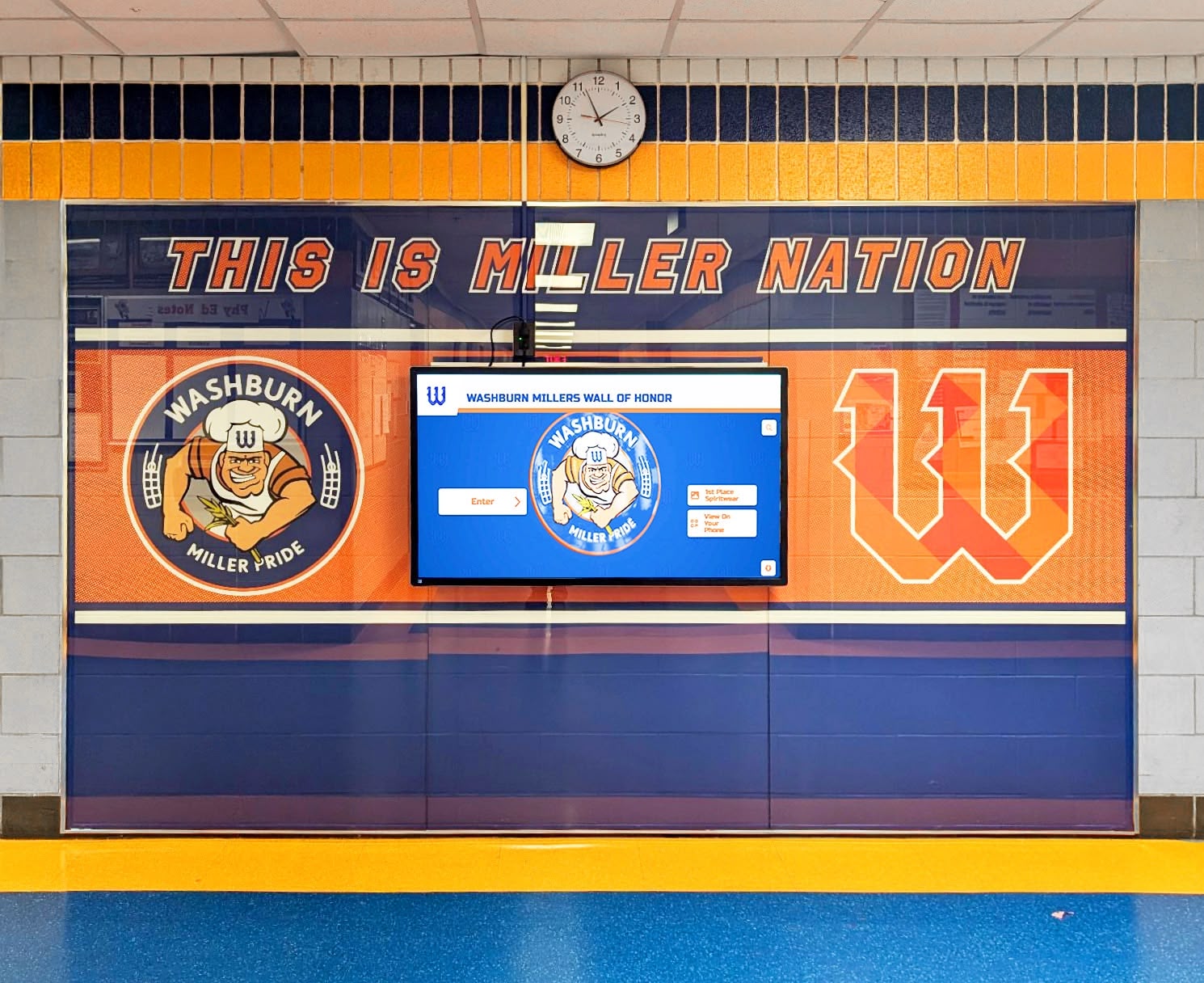
Integrating Alumni Recognition with Institutional Advancement
Recognition programs deliver maximum value when integrated with broader advancement, engagement, and development strategies rather than operating as isolated initiatives.
Recognition and Fundraising Connections
Strategic recognition strengthens fundraising efforts through multiple mechanisms:
Cultivation and Stewardship: Recognition programs identify accomplished, engaged alumni representing prime major gift prospects. Inducted alumni demonstrate institutional affinity worthy of cultivation attention while recognition ceremonies create natural touchpoints for advancement relationship building. Following recognition with appropriate development conversations converts gratitude into philanthropic commitment for many honorees.
Reunion Integration: Coordinate recognition with reunion years, maximizing attendance and engagement while creating compelling class giving campaign themes. Honoring distinguished class members during milestone reunions generates pride motivating reunion giving while strengthening class identity and connection.
Named Recognition Opportunities: Recognition displays themselves create naming opportunities—sponsors can fund program endowments, underwrite specific recognition categories, or support display installations. This dual recognition—honoring achievement while acknowledging sponsor support—creates sustainable funding models for program operations.
Guidelines on collegiate donor recognition demonstrate effective integration of appreciation, advancement, and engagement strategies creating comprehensive systems serving multiple institutional priorities.
Student Engagement and Mentorship
Recognition becomes educational when programs connect honored alumni with current students:
Campus Visits and Speaking: Invite inductees to deliver talks, participate in career panels, teach guest lectures, conduct workshops, or engage in informal student conversations. These interactions bring recognition to life while providing students with valuable insights, advice, and inspiration from accomplished role models with authentic institutional connections.
Mentorship Program Integration: Recognized alumni represent ideal mentor candidates given demonstrated achievement and institutional commitment. Formal connections between recognition and mentorship programs create structured pathways channeling honoree engagement into sustained student support.
Career Exploration Resources: Recognition displays organized by career field help students explore professional pathways through alumni example. Interactive elements enabling students to indicate interests and receive relevant alumni profile recommendations create personalized career exploration experiences supporting academic and professional development.
Strategies for engaging alumni in student support demonstrate how recognition programs create foundations for meaningful ongoing engagement beyond ceremonial acknowledgment.
Communications and Marketing Value
Alumni achievement stories provide compelling content for institutional communications:
Recruitment Materials: Prospective students and families want evidence that education leads to meaningful success. Recognition programs provide tangible examples demonstrating diverse pathways to achievement graduates have pursued. Feature recognition content prominently in admissions materials, campus tour scripts, and prospective student communications.
Public Relations: Local, regional, and national media often cover distinguished alumni stories, particularly when honorees have achieved recognition beyond institutional boundaries. Recognition announcements provide newsworthy content strengthening institutional media relationships while generating positive visibility.
Social Media Strategy: Alumni recognition delivers authentic, compelling social media content throughout the year. Feature different honorees regularly, share career milestone updates, celebrate achievement anniversaries, or highlight historical inductees creating ongoing engagement rather than limiting recognition visibility to annual ceremony periods.
Institutional Pride: Recognition demonstrates institutional quality through graduate success. Comprehensive programs documenting decades of distinguished achievement create cumulative evidence of educational value, mission accomplishment, and lasting impact on individuals, communities, and fields.
Special Considerations for Different Institution Types
Recognition program design should reflect institutional context, size, mission, and stakeholder characteristics ensuring appropriate approaches aligned with specific circumstances.
High School Alumni Recognition
Secondary school programs face unique considerations given younger alumni populations, local community focus, and resource constraints:
Programs often emphasize young alumni achievement celebrating early career success, community service contributions, and accomplishments occurring within 10-20 years of graduation. This timeframe maintains relevance for current students who can relate to relatively recent graduates while honoring achievement appropriate to career stage.
High schools typically integrate athletic recognition prominently, celebrating sports achievement alongside academic and career accomplishment. Comprehensive programs recognize excellence across athletics, academics, arts, community service, and professional careers demonstrating institutional commitment to holistic education valuing diverse talents.
Local community connection matters significantly in high school contexts. Recognition honoring alumni serving local communities, supporting local institutions, or maintaining hometown connections resonates powerfully with student audiences considering their own futures and relationship with home communities.
College and University Recognition
Higher education institutions maintain more complex programs given larger populations, diverse degree programs, and geographic dispersion:
Universities commonly implement school or college-specific recognition alongside institution-wide honors. Engineering schools recognize technical achievement, business schools celebrate entrepreneurial success, medical schools honor healthcare contribution, and arts colleges acknowledge creative professional accomplishment. This specialized recognition enables deeper celebration of field-specific achievement while maintaining cohesive institutional identity.
Graduate and professional degree recognition requires appropriate differentiation from undergraduate honors. Doctoral degree recipients, medical school graduates, law school alumni, and other advanced degree holders merit recognition acknowledging specialized achievement and professional contribution distinct from undergraduate education.
Research universities particularly value recognition celebrating scholarly contribution—publications, patents, research impact, academic leadership, and scientific advancement. These achievements may prove less immediately comprehensible to general audiences but deserve celebration equal to business success or public service for institutions defining themselves through knowledge creation and dissemination.
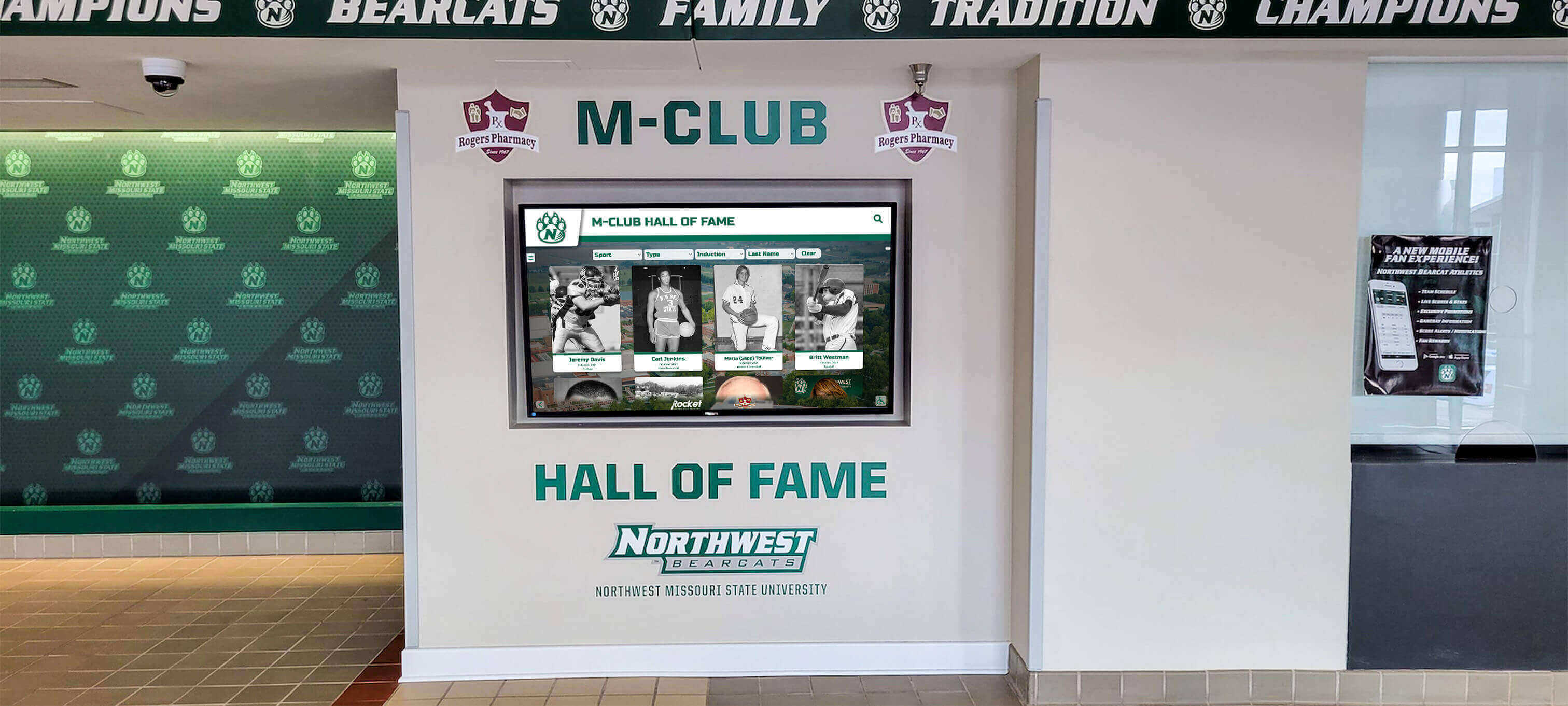
Religious and Mission-Driven Institution Recognition
Faith-based and mission-focused schools appropriately emphasize values alignment and mission contribution:
Recognition criteria naturally incorporate service, character, ethics, and mission demonstration alongside professional achievement. Alumni living institutional values through careers, community contributions, or life choices merit celebration even when conventional achievement metrics prove less spectacular than alumni in high-profile fields.
Ministry, missionary work, nonprofit leadership, teaching, counseling, and other service-oriented careers deserve recognition equal to business or professional success in mission-driven contexts where values emphasize service over personal advancement.
Programs should celebrate diverse ways graduates embody and advance institutional missions through daily lives and career choices, not exclusively through high-profile achievement or wealth accumulation potentially conflicting with institutional values emphasizing other life priorities.
Emerging Trends and Future Directions in Alumni Recognition
Recognition programs continue evolving as technology advances and stakeholder expectations shift, creating opportunities for innovation while maintaining core celebration purposes.
Inclusive Recognition and Diverse Excellence
Contemporary programs increasingly emphasize inclusivity, celebrating achievement across all backgrounds and avoiding historical biases favoring certain demographics or career paths:
Institutions deliberately seek and celebrate alumni from underrepresented groups, international graduates, first-generation students, non-traditional learners, and individuals pursuing unconventional paths. This intentional diversity demonstrates that achievement opportunities exist for all students regardless of background while providing varied role models reflecting diverse student body composition.
Recognition of community-based achievement, creative professional success, social entrepreneurship, nonprofit leadership, education, and service careers balances traditional emphasis on corporate or professional success. Broadened definitions of achievement acknowledge multiple ways to create value and impact beyond conventional career ladders.
Continuous Recognition Beyond Annual Cycles
Digital platforms enable ongoing recognition rather than limiting acknowledgment to annual ceremony cycles:
Spotlight features highlighting different alumni monthly or quarterly maintain recognition visibility throughout the year. Milestone celebrations acknowledging career achievements, publications, awards, or life events create natural recognition opportunities beyond formal induction programs. Alumni achievement updates keep recognition current while encouraging ongoing engagement and information sharing.
This continuous approach transforms recognition from annual events into sustained programs maintaining year-round visibility while creating multiple touchpoints strengthening alumni connection and engagement.
Integration with Career Services and Professional Development
Recognition systems increasingly serve career exploration and professional development purposes:
Digital displays organized by career field, industry, or job function help students explore professional pathways through alumni example. Filtering capabilities enabling searches by major, minor, activities, or interests connect current students with alumni sharing similar backgrounds facilitating relatable role model discovery.
Direct messaging or connection request features built into recognition platforms enable students to reach out to alumni for informational interviews, advice, or mentorship. This integration transforms recognition from passive viewing into active networking and professional development resources supporting student success while creating meaningful alumni engagement opportunities.
Institutions implementing academic excellence recognition can extend these systems to honor scholarly achievement while supporting current student academic and career development through alumni connection.
Conclusion: Building Alumni Recognition That Creates Lasting Value
Alumni recognition programs serve institutions most effectively when they transcend ceremonial acknowledgment, becoming strategic initiatives strengthening community bonds, advancing institutional missions, inspiring student success, and celebrating achievement in ways that honor individuals while creating collective value. The most impactful programs combine rigorous selection ensuring recognition maintains prestige and meaning, compelling storytelling that brings achievement to life through multimedia-rich profiles, accessible displays reaching broad audiences beyond campus boundaries, and integrated operations connecting recognition with advancement, engagement, student support, and communications priorities.
Traditional recognition approaches—engraved plaques, trophy cases, naming opportunities—maintain value for institutions favoring tangible permanence and stakeholder preferences for physical displays. These conventional formats convey gravitas and formality appropriate for distinguished achievement while creating impressive installations commanding attention in prominent campus locations.
Modern digital recognition systems overcome space constraints limiting physical displays, enable rich multimedia storytelling impossible with static plaques, provide unlimited capacity accommodating comprehensive recognition across decades and achievement types, deliver real-time updates maintaining currency, extend recognition globally through web accessibility, and generate analytics informing continuous improvement. Digital platforms particularly benefit institutions seeking to honor broad alumni populations, maximize recognition reach, minimize ongoing maintenance burden, and create engaging experiences resonating with contemporary audiences.
Many institutions find hybrid approaches combining physical and digital elements most effective—maintaining traditional recognition elements satisfying stakeholders valuing tangible displays while implementing digital systems providing expanded capacity, content richness, and engagement capabilities. This balanced strategy honors tradition while embracing innovation addressing practical constraints and evolving expectations.
Beyond display technology, recognition program success depends on operational excellence ensuring sustainable processes, consistent quality, transparent selection maintaining credibility, compelling content honoring achievement appropriately, strategic integration with advancement priorities, and continuous assessment informing improvement. Programs executed with attention to these dimensions create lasting value justifying continued investment while serving multiple institutional priorities simultaneously.
For schools and organizations ready to honor alumni heritage while building engagement, modern recognition programs provide proven approaches delivering measurable impact. Whether implementing comprehensive digital platforms, enhancing existing programs, or launching new recognition initiatives, the strategies and frameworks explored throughout this guide offer practical starting points for creating acknowledgment systems celebrating achievement while advancing institutional missions and strengthening communities connected through shared educational experiences.
Ready to transform alumni recognition at your institution? Explore how digital recognition solutions enable comprehensive celebration of every deserving graduate while creating engaging experiences that inspire students, strengthen connections, and demonstrate institutional quality through decades of graduate excellence documented accessibly for current and future generations.
